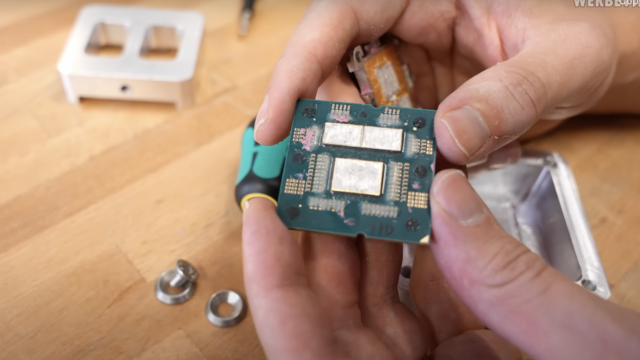Overclocker Delids AMD Ryzen 7900X, Lowers Temps by 20C

One of the most surprising bits of news from this week’s Zen 4 launch was how hot AMD’s newest CPUs can get. This is by design, according to AMD, but it conjures up thoughts of a Star Wars meme: You were supposed to destroy the Sith (Intel), not join them! AMD has joined the dark side though, with its new high-end hips running at 95C, even on beefy liquid cooling setups. As we reported previously, they consume more power than any previous AMD processor—more than 200 watts.
A key culprit for these high temps is supposedly the extra thick integrated heat spreader (IHS). AMD apparently made it this way to guarantee compatibility with older AM4 coolers. Naturally, overclockers have already gone to work on the new chip to see what how effective direct-die cooling would be by delidding the CPU. The results are pretty surprising, but it’s not something a casual enthusiast should ever attempt.
Noted overclocker Der8auer is a delidding expert, so he figured he’d try it out on AMD’s latest CPUs. As you are aware, AMD’s IHS design is a bit different from Intel’s, with cutouts all around the edges. This makes the delidding process a bit more complex than normal, so he had to create a prototype mechanism. It clamps down onto the IHS, then uses pressure from opposite directions to shift the IHS 1mm back and forth until it comes loose. With the “lid” removed, he then fabricated a frame to go around the CPU to hold the cooler in place. With help from AMD CAD files and his own 3D scanner, he could design a frame and mill it on a CNC machine.
[embedded content]
He also notes that Zen 4’s backplate mounts directly to the socket mounting mechanism. It’s called a socket actuation mechanism, or SAM for short. This means an AM4 cooler with a backplate will not work on AM5 without some kind of adapter, a pretty big caveat in AMD’s claim that AM4 coolers will work with AM5.
With his frame built, and the chiplets exposed, he gingerly mounted his cooler to the chip. It’s comprised of a 360mm corsair radiator and fans with a custom pump, reservoir, and tubing. Before doing all the legwork to remove the lid, he ran Cinebench with a stock setup for a baseline. The CPU was clocked to 5.4GHz across all cores, and hit temps of 90C. Once delidded, he ran the test again with the same clock speeds, same BIOS, and same voltage. Surprisingly, the chip was able to run Cinebench at a chilly 70C. That’s a shocking 20C drop in temps with everything else unchanged. One ancillary benefit of the experiment is the chip consumed about 15W less power due to the lower temps. He was also able to bump the clocks up 100MHz by adding 30 millivolts of juice. That gave him 5.5Ghz across all 24 threads.
This is a stark departure from previous Ryzen delidding experiments. We found a video of his from 2017 where he delidded a Ryzen 7 1800X, and found almost no temperature difference. It all comes down to the thermal interface material (TIM) design by AMD. For Zen 4 AMD uses solder, which is better than regular thermal paste. However, the thick IHS might be contributing to the chips’ high temperatures.
Overall, most people will not want to jeopardize their expensive processors to attempt this. However, it’s an interesting look at the possibilities Zen 4 offers to modders. It also shows that Zen 4 CPUs can run nice and cool, even overclocked. Also, it’s possible Der8auer will make his delidder mechanism and CPU frame available at retail. He’s done that in the past for previous CPUs. You will still need to be extremely careful when using it, though—and be able to withstand the death of your CPU, should things go sideways.
Now Read:

Comments are closed.